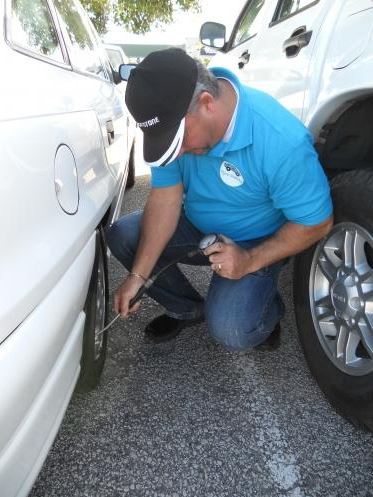Tyres fitted to vehicles in Bloemfontein are near the top of the heap for inflation pressure and condition. This emerged from Bridgestone’s latest Tyre Check survey, conducted in the car park of the Southern Centre Pick n Pay on 24 August.
“Although Bloemfontein’s drivers didn’t get into the bracket of the Centurion survey earlier this year where a record 98% of tyres were correctly inflated, they have taken the runner-up spot,” said Bridgestone PR Manager, Mandy Lovell. “The important finding from Bloemfontein is the fairly low levels of tyres whose inflation pressure was classified as ‘extremely dangerous’,” she added.
Tyres recorded as ‘extremely dangerous’ in the Tyre Check surveys are those whose pressure is below 150kPa or above 290kPa. Tyres are also classified as ‘dangerous’ if the pressure is below 180kPa but above 150 kPa, or as ‘fine’ if the pressure is between 180kPa and 290kPa. Only 4% of tyres fell into the ‘extremely dangerous’ category in Bloemfontein, versus 7% in Port Elizabeth and 8% in Germiston in Tyre Check surveys conducted during 2013.
Bloemfontein also had fairly low levels of tyres which were unsafe due to excessive treadwear or damage like cuts, bruises and bulges. Just 4% of tyres surveyed had these kinds of defects, just behind the 3% recorded in Centurion, but well ahead of Germiston (6%) and Port Elizabeth (7%).
The Bloemfontein Tyre Check surveyed 1256 tyres fitted to 314 cars. Apart from condition and inflation pressure, the team of Bridgestone tyre specialists also checked each vehicle for mis-matches between tyre makes and tread patterns. This problem is fairly common, but can lead to unpredictable roadholding and braking. Only 3% of vehicles surveyed in Bloemfontein had mis-matched tyres, a far cry from the shocking 20% mis-match rate noted in Germiston earlier in 2013.
Lovell said that 2013 had been one of the most productive years for the Tyre Check programme. “Tyre Check has been running for seven years, and this year we’ve checked over 4600 individual tyres in four different locations,” she said. “The data we have collected from the programme has been very helpful in the tyre training programmes we run for organisations like SANParks,” she added. “Most people tend to take tyres for granted, but when trainees see how tyre condition gets neglected in the real world – and what the consequences can be – their mindset towards their tyres changes immediately,” she commented.
She reminded law enforcement agencies that they were welcome to contact her for access to the tyre data to assist their enforcement efforts. “Tyre condition data can make law enforcement easier by helping officers identify the kind of defects which are more likely to occur in their region,” she explained. “Targeting common tyre defects is an important way to reduce the risk of crashes caused by tyre failure,” she concluded.
Also view: Safe Driving and Tyre Safety
